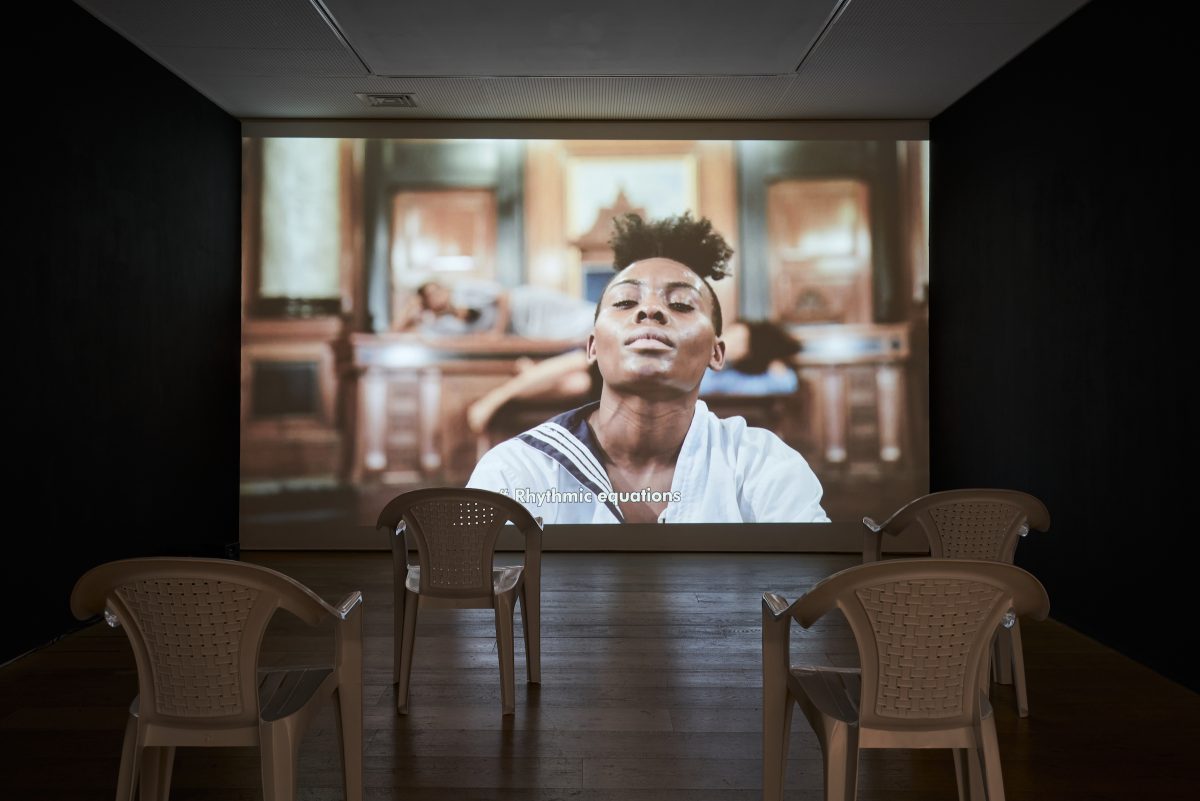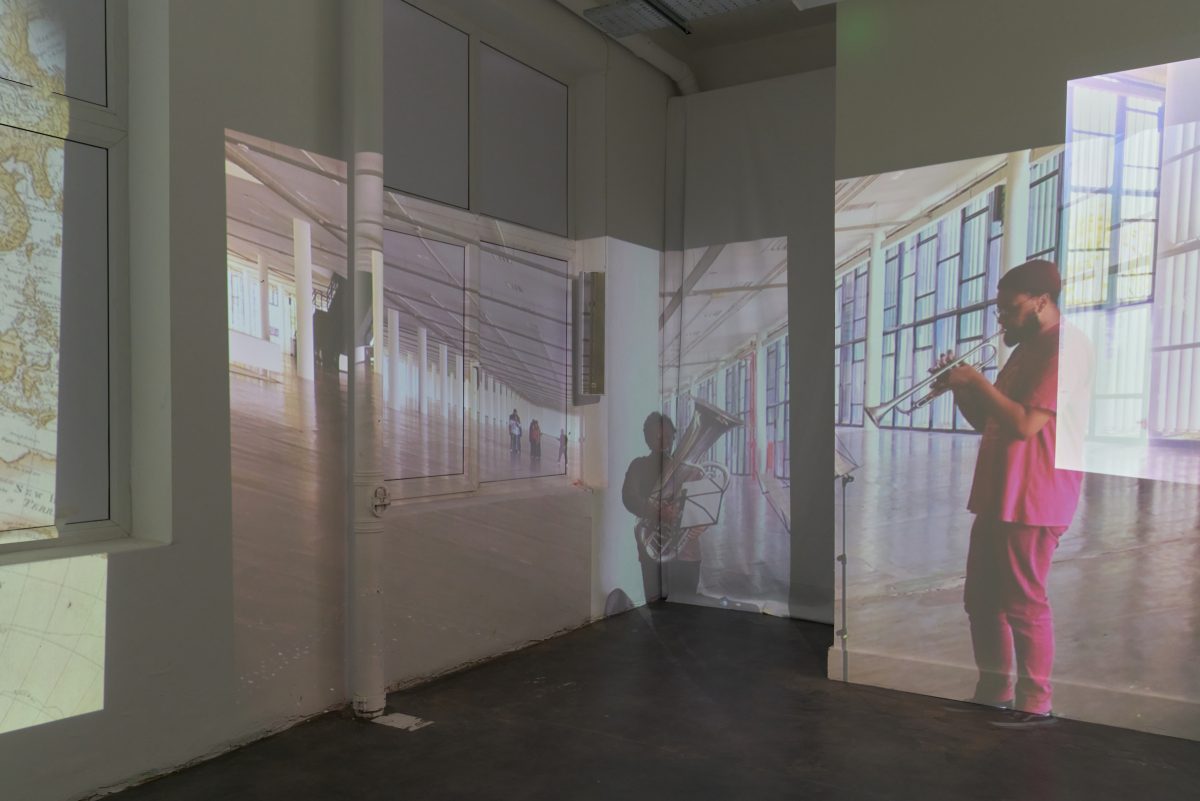

LIVERPOOL, UK — A sonic thread runs through this year’s Liverpool Biennial. From Turner Prize nominees BOSS’ installation “The Only Good System Is a Sound System” (2021), to the work of Scotland’s representative artist for the next Venice Biennale, Alberta Whittle, with “between a whisper and a cry” (2019), sound is an integral part of the works on view.
David Zink Yi’s engrossing installation “Horror Vacui” (2009) switches between a close focus on percussionists, and scenes of band rehearsals and Afro-Cuban rituals, all of which appear to have been filmed separately but blend seamlessly. The film is installed at the Martin Luther King building and shown on two enormous screens in an otherwise open space. In this sparse setting, the effect is symphonic, but by placing the work in this context, it raises the question, is the art in the performance or in the recording? As the auteur, but also a member of De Adentro y Afuera, the band featured in the film, Zink Yi blurs the lines between participation and extraction.

Entitled The Stomach and the Port, this iteration of the biennial draws attention to the similarities between the two entities as spaces of encounter, of material passing through, and of transformation. The notion of the port is clear, perhaps even obvious. The stomach, however, is a more abstract, unwieldy concept. A number of the works on view center aspects of the human anatomy, creating a disconnect between those which considered the totality of a human experience, and those which focused on the body alone. It is worth bearing in mind that The Stomach and the Port was originally slated to take place in 2020. In the aftermath of a global pandemic when injustice and inequality have determined the outcomes of people’s health, and ultimately their lives, what might have once appeared light-hearted now rings a little hollow.
As a maritime city, once a major center of commerce for the British Empire, Liverpool was a hub through which all kinds of cargo passed — including enslaved Africans and the goods their labor produced. The transatlantic slave trade and the subsequent colonial period have had an indelible imprint on the architecture of the city — from the names of buildings such as West Africa House, to the grand public buildings and memorials built by the wealth brought in from the colonies.

One such building is the Cotton Exchange in the Business District, a nondescript mid-century structure that replaced the city’s previous exchange, built in the early 1800s. The accompanying guide suggests a number of trails — walking routes themed around elements drawn from the overall curatorial concept — that visitors can use as entry points to the biennial. The Cotton Exchange is one of the stops along the “Porosity” trail, with Xaviera Simmons among the three artists whose work is exhibited in the green tiled basement. Both of her photographic series Sundown (2018-ongoing) and Index (2011-ongoing) have a tactile quality to them, layered in meaning as well as appearance. In Index, the female subject of each picture has her skirt completely raised, the patterned fabric obscuring her upper body. A montage of images, objects and archival clippings is held together with clothes pegs underneath her skirt. Each image is heavy with the weight of many lifetimes of accumulated memories, an inheritance that is equally joyful and burdensome. Alongside the hung photographs, Simmons displays three film works, one of which lists the names of slave owners and the number of enslaved people in their possession. In this former site for merchants to exchange commodities, Simmons makes visible the connection between monetary value and human costs of production.

The Biennial has always utilized Liverpool’s public spaces as well as more formal or traditional art venues, sometimes clumsily so, but this edition feels particularly well incorporated into the everyday quotidian routine of the city. Larry Achiampong’s “Pan-African Flags For the Relic Travellers’ Alliance” (2021) dot along buildings around the city center, blowing in the maritime air, in solidarity with African peoples on the continent and in the diaspora, but also in remembrance of their struggles both past and present.
One of the most striking works is accessed by climbing three flights of stairs to the otherwise unused top floor of the Lush cosmetics store. Crammed into a tight corner room of the large makeshift gallery, “A Maze In Grace” (2021) by sound artist Neo Muyanga, is an unnerving, intentionally claustrophobic experience. A South African opera singer performs the artist’s composition, inspired by the hymn “Amazing Grace,” written by slave owner turned abolitionist — and Liverpool resident — John Newton. There is no obvious space to sit still and observe, with projections of sheet music and archival photography alternating from one part of the room to another, like a spotlight searching for an unsuspecting subject — the viewer. All the while a low, slow thump in the background and the sound of a drip build up the viewer’s anxiety. The work serves as a reminder of how we are still entangled in the legacy of these histories. Muyanga originally intended to perform the piece live but this was unable to take place due to the pandemic. It is hard to imagine how much more emotive the work would have been.

If there is an intangible, ethereal quality to the film and sound works that seem to exist outside of conventional time, the physicality of Kathleen Ryan’s sculptures, Bad Fruit (2020), root us in the present. Her giant rotting fruit sculptures — a lime, a peach and a pair of exquisite cherries — are equally beautiful and grotesque. Made up of semi-precious gemstones as well as man-made materials such as glass and polystyrene, the works do away with the separation between natural and artificial, prodding at the economic extraction of resources and the human and non-human costs associated with it — a label explains that the most expensive stones are reserved for the most rotten parts of the fruit. The wire pins holding each piece of the sculpture have an honesty about them; evidence of the combined effort keeping the structure from falling apart.
In the midst of the collapse of many familiar structures — in the art world and in wider society — The Stomach and the Port both reveals the rot that is no longer contained and remains a part of those structures. It too is weighed down by the history and society within which it exists.

The 2021 Liverpool Biennial: The Stomach and the Port continues through June 27 at various venues throughout Liverpool, UK. The exhibition was curated by Manuela Moscoso.
0 Commentaires